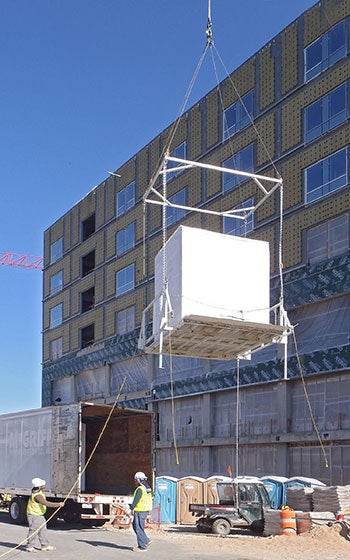Prefabricated elements cut costs and time from new hospital project
 |
| PHOTO COURTESY OF MORTENSON CONSTRUCTION Crane operators lift a prefabricated bathroom pod into place at the Saint Joseph Heritage Project. |
Incorporating prefabricated elements into the building of SCL Health’s Saint Joseph Hospital Heritage Project, Denver, cut costs by $4.3 million and six months’ construction time compared with using traditionally installed components.
Utilizing prefabricated elements enabled construction firm Mortenson Co., Denver, to meet the health care system’s 30-month construction deadline so that the new 831,000-square-foot, 360-bed hospital could be occupied and operational in December. Traditional construction elements would have required six more months to complete the project, company officials say.
Mortenson chose to prefabricate the exterior wall panels, bathroom pods, patient room headwalls and multisystem racks that include medical gas piping, ductwork, electrical wiring and pneumatic tubing installed above ceilings.
Many of the components were built in Denver area warehouses and delivered to the construction site; bathroom pods were built in Boston and trucked to Denver.
The redundancy of components throughout the hospital made prefabrication an ideal solution, says Brandon Bergholz, senior project manager, Mortenson. The number of prefabricated components installed included 440 bathroom pods, 346 exterior wall panels, 376 patient room headwalls and 166 25-foot multisystem racks.
Prefabrication cut costs by making construction more efficient and reducing thousands of hours in labor costs, he says. Other benefits are improved safety by eliminating mechanical lifts to move materials and workers for installation.
Quality control is improved because prefabricated components are built in a warehouse under controlled conditions rather than on the project site where weather becomes a factor, Bergholz adds.
Saint Joseph represents the first time the company installed multiple prefabricated components in the same project, he says.
An aggressive construction schedule and a readiness to increase the use of prefabrication prompted the company to incorporate more elements in this project. “We had the buy-in of everyone on the team and we just made it happen,” Bergholz says.




